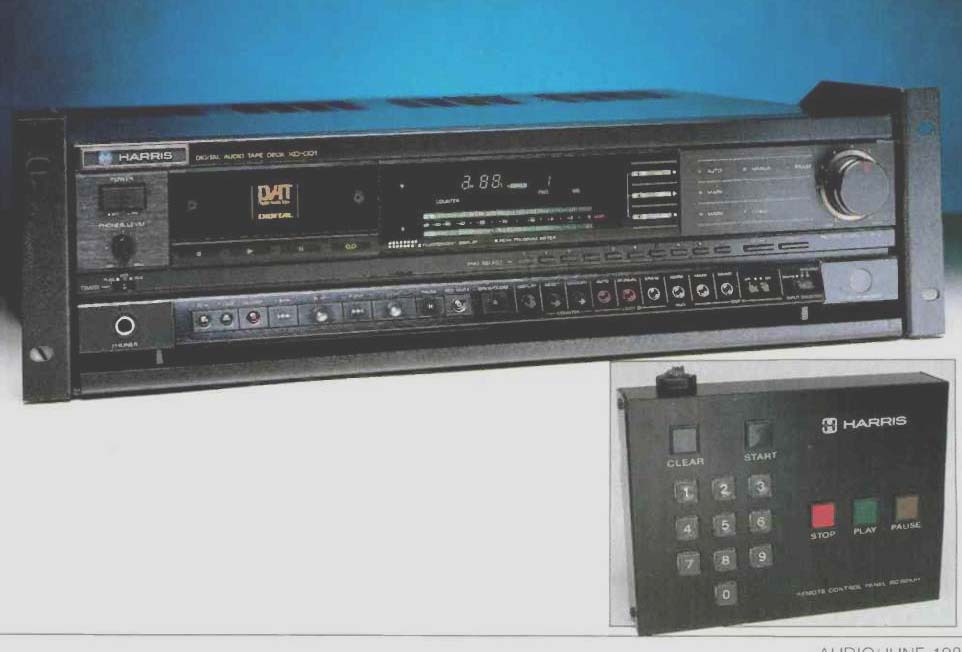
Manufacturer's Specifications:
Frequency Response: 2 Hz to 22 kHz, ±0.5 dB.
Dynamic Range: 90 dB or greater.
S/N Ratio: 92 dB or greater.
THD: 0.005% or less at 1 kHz.
Sampling Frequencies: 44.1, 48, and 32 kHz for playback; 48 kHz for recording via all inputs, 32 kHz for recording via digital inputs only.
Input Levels and Impedances: Line in. 0.25 V, 50 kilohms; digital in, 0.5 V peak to peak. 75 ohms.
Output Levels and Impedances: Line out, 0.25 V. 470 ohms (into 10 kilohms or more); digital out, 0.5 V peak to peak, 75 ohms; headphone out, 32 to 150 ohms.
Power Requirements: 120 V a.c., 50 60 Hz, 35 watts.
Dimensions: 17 in. W x 4 3/8 in H x 16 9/16 in. D (43.1 cm x 11.75 cm x 42.1 cm).
Weight: 25 3/8 lbs. (11.7 kg).
Price: $1,550 with infrared remote; wired remote. $160.
Company Address: Harris Corp., Broadcast Div., P.O. Box 4290, Quincy, Ill. 62305.
Major record companies continue to intimidate and threaten manufacturers of DAT recorders with all sorts of dire consequences if they dare to bring consumer DAT recorders to this country. Still, one way or another, DAT recorders are becoming available here for those who really need or want them. Some are classified as "professional" models and are sold only through distributors of professional recording equipment. Often, these pro modes are essentially no different from the consumer models sold by the same companies in countries where such threats have not been made. For example, I own a little portable DAT recorder that I purchased in Japan. At a recent AES Convention, I saw the "professional" version of the same machine. About the only difference I could detect between my "consumer" portable and the "pro" model was that the latter was equipped with balanced XLR three-pin connectors, whereas my machine had unbalanced phono-type input and output jacks.
There's even less difference between the DAT recorder I've just tested, sold here by Harris (a well-known supplier of communications equipment to the broadcast industry) and the model sold by Harris' supplier in Japan. One small difference between the tested unit and its consumer equivalent is a tiny receptacle on the rear of the tested unit which accepts a cable from an optional wired remote control. (A wireless remote is included in the price of the machine.) The wired remote and provisions for 120-V power are Harris' manufacturing contributions to this DAT recorder.
Although the unit will recognize and play DATs recorded at either 44.1 or 48 kHz, it will not permit digital dubbing of 44.1-kHz prerecorded DATs. Furthermore, it will not permit digital dubbing of any software that has been recorded with the "copy inhibit" flag. In other words, it is configured exactly like all other consumer DAT machines available in other countries.
Having said all that, I hasten to add that the XD-001 UH is a full-featured DAT recorder. The optional wired remote, which I used, allows you to easily select any track on a DAT. "Start ID" subcodes and program numbers can be automatically recorded or can be added in post-production work.
When these identifying data are used to locate desired tracks, the deck can be made to start play immediately or to go into standby, ready to play the track when commanded.
Other features include high-speed music search, tape scan (which allows you to preview the first 8 S of each track), a multi-function counter (which displays elapsed time, remaining play time, or playing time of the current selection), high-speed audible cue and review, timer recording and playback, and optional remote start/stop capability from a suitably equipped console. The unit I reviewed was also packed with the wireless remote control normally supplied with this machine.
Control Layout
A power switch, "Phones Level" control, time switch, and stereo headphone jack are all mounted at the left end of the panel near the cassette drawer. Major transport controls are found beneath the drawer, and an elaborate display area is to the drawer's right. This display has a pair of bar-graph level meters plus indicators for time, sampling frequency, program number, program cueing, start and skip ID, search, "Caution," and "Copy Prohibit." A "Memory" indicator shows up in the display when the "Memory" button has been pressed to allow rewinding to the 0 minutes and 0 seconds point on the counter.
Numbered buttons, beneath and to the right of the display, are used in conjunction with a "Start" button for direct access to any program number. Program-number "Clear" and "Start" buttons are a little further to the right. Beneath the program-number keys are buttons for "Display," "Counter" ("Reset" and "Memory"), "Start ID" ("Auto," "Manual," and "Erase.'), and program-number "Mark," plus two buttons and a switch for "Skip ID." Also found here are an input selector (for digital and the two analog inputs) and the sensor for the wireless remote. Above the sensor is a concentrically mounted pair of record-level controls.
The rear panel of the Harris XD-001 UH is equipped with unbalanced analog input and output jacks as well as a digital input and a digital output jack.
The optional wired remote duplicates the number keys found on the front panel, in addition to "Stop," "Play," and "Pause" buttons for the tape transport, and cueing "Clear" and "Start" buttons. "Start" allows you to initiate play of any selection after it has been cued up by the other controls; it also allows you to pause at any time during playback.
"Local" and "Remote" buttons on the current version of the remote (not shown) determine whether the XD-001UH will be primarily controlled from its front panel or from this remote; most functions, however, can be used from either the front panel or the remote, regardless of this switch's position.
Measurements
Having now had an opportunity to test several DAT components, both players and recorder/players, I am gradually formulating what I hope is a reasonable and comprehensive set of tests with which to define the performance of these amazing machines. In this respect, I am in what amounts to uncharted territory. An EIA committee is only now being formed to develop standards for measuring DAT recorders, and the IEC (International Electrotechnical Commission), on which I serve as a U.S. delegate, is also still in the early stages of developing a standard. So, I am pretty much on my own, and if any of you have any suggestions, I would welcome them.
It seems to me that in measuring a DAT recorder that has both record and playback capability, it would be interesting to determine how closely an analog recording (made at 48 kHz) approximates recordings that are digitally generated.
As readers who have been following my DAT adventures know, I now have a DAT test tape (at 44.1 kHz) that is the digitally generated equivalent of the CD-1 disc I have been using to test CD players. Thus, I am able to compare playback results of this tape with playback of the same tracks recorded and played back via the analog inputs and outputs of a DAT machine. The latter recordings are, of course, made at 48 kHz. As you will see shortly, the differences in final performance between recordings made with these two techniques, while not great, are nevertheless quite measurable.
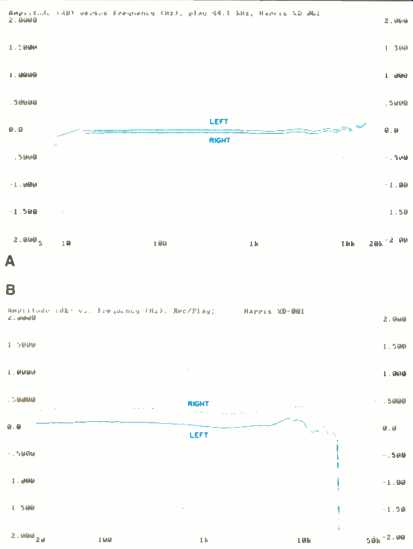
Fig. 1--Frequency response for playback of test tape prerecorded at 44.1 kHz
(A) and for playback of same signals recorded via analog inputs at 48-kHz sampling
rate (B).
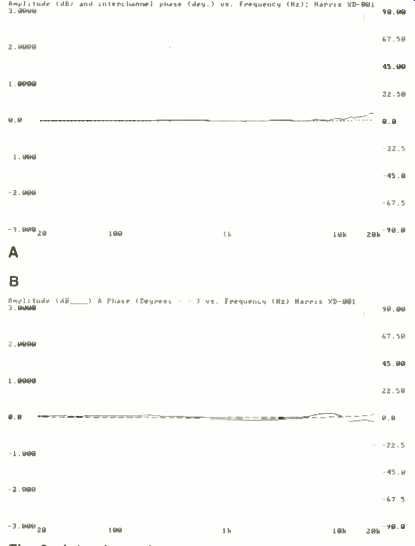
Fig. 2--Interchannel phase difference (dashed curve) and frequency response
(solid curve) for playback of prerecorded test tape (A) and for playback of
same signals recorded via analog inputs at 48-kHz sampling rate (B).
Figure 1A shows the frequency response of the XD-001 UH when it simply played back my prerecorded CD-1 test tape. A slight rise in response, amounting to no more than +0.23 dB, is evident at 20 kHz, as is a slight amount of ripple-no doubt caused by the anti-aliasing filters ahead of the outputs. By contrast, when a recording of the same frequency sweep was made through the analog inputs of the DAT recorder, response differed somewhat at the high end, exhibiting a slight rise in the region from 5 to 10 kHz and a very slight attenuation of around-0.15 dB at 20 kHz (Fig. 1B). In this plot, I extended the horizontal axis to 50 kHz in order to observe how steeply response drops off above 22 kHz. (The response for the right channel, virtually identical with that of the left, has been deliberately shifted from the 0-dB axis for the sake of clarity.) Playback of the same frequency sweeps from the prerecorded test tape yielded no measurable phase shift between channels, as indicated by the dashed curve in Fig. 2A. (The solid curve is simply a repeat of the frequency response data shown in Fig. 1A.) Again, confirmation of the slightly altered response obtained by first recording the sweep through the analog inputs is evident in Fig. 2B, as is the introduction of a very slight amount of phase shift (no more than about 2°) between channels at 20 kHz. This slight phase shift must have been caused by the analog input stages that were not involved in the playback-only tests in Fig. 2A. A much more substantial difference was noted between the two modes of operation when S/N ratios were measured.
During playback of the "silent" track of my prerecorded (44.1-kHz) CD-1 equivalent test tape, S/N was an impressively high 110.5 dB on the left channel and 109.8 dB on the right. When I recorded the same "silent" track onto a DAT via the analog inputs of the XD-001 UH, using the actual CD 1 Compact Disc as my source, that section of the tape had an S/N ratio of 92.5 dB on the left channel and 86.6 dB on the right in playback. So much for the recording industry's argument that analog recordings made on DAT recorders would be "clones" of the digital originals! (All S/N measurements were referred to the 0-dB reference output level of 2.09 V and were made using an A-weighting filter.) It is not possible to say with certainty how much of the decrease in S/N was caused by the input stages of the DAT recorder and how much was attributable to the residual noise emanating from the CD player I used to play the silent track of the CD-1. However, since the S/N of my reference CD player is greater than 100 dB, I would guess that much of the difference must be attributed to the DAT recorder's analog input circuitry.
To further analyze the residual noise characteristics of the XD-001 UH under both playback-only and record/play conditions, I used my Audio Precision test system to do an unweighted spectral analysis of the residual noise. Results, for playback of the prerecorded test tape and for a complete record/play cycle, are shown in Fig. 3. In the playback-only test, the noise did not rise above-117 dB in any third-octave frequency band. By contrast, when analyzing the complete record/play cycle (again using the analog inputs of the DAT machine), a 60-Hz noise component attributable to the power supply became evident; its amplitude reached a peak of-102.5 dB for the left channel and-100 dB for the right.
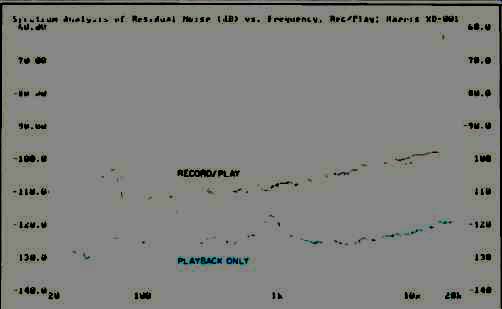
Fig. 3--Unweighted spectrum analysis of residual noise for playback of prerecorded
test tape as well as record/play of same signals. Solid curve is for the left
channel and dashed curve for the right.
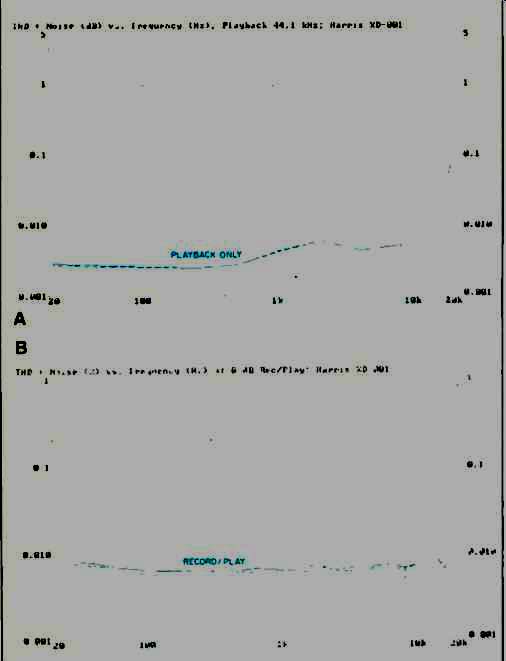
Fig. 4--THD + N for playback of prerecorded test tape (A) and for record/play
of same signals at 0-dB recording level (B); see text. Solid curve is for the
left channel and dashed curve for the right.
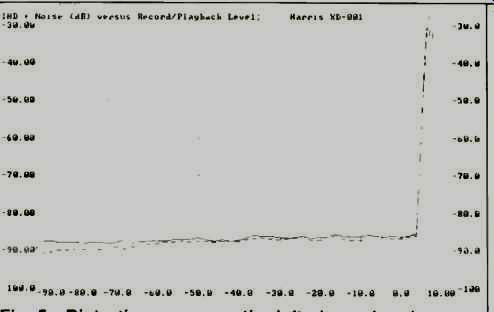
Fig. 5--Distortion vs. recording level, for recording via analog inputs. Solid
curve is for the left channel and dashed curve for the right.

Fig. 6A--Separation vs. frequency for playback of prerecorded test tape.
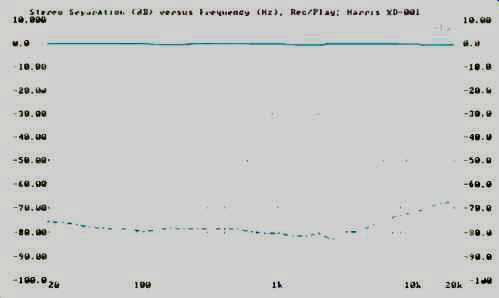
Fig. 6B--Separation (dashed curve) and frequency response (solid curve) for
recording made via analog inputs.
Figure 4A shows how THD + N varied with frequency when I played back a 0-dB frequency sweep from the prerecorded digital test tape. At 1 kHz, THD + N measured 0.0045%; even lower values were recorded at lower frequencies, and a THD figure of 0.2% was noted at 20 kHz.
When I recorded the same sweep via the analog inputs of the XD-001 UH and played back the tape, a higher overall level of THD + N was noted as well as a significant rise in THD at the extreme bass end of the spectrum (Fig. 4B). Under these conditions, THD + N at 1 kHz was 0.007% on one channel and 0.006% on the other. Like me, you may be wondering why THD + N at 20 kHz turned out to be less this time than when the digitally recorded test tape was played back. The answer must be that some of the distortion components generated during recording were out of phase with similar components generated during playback, so that some cancellation took place. I often encounter this same sort of thing when I measure stereo FM tuners and find that stereo THD is actually lower than mono THD in many cases.
I wanted to determine how critical recording levels are for this DAT recorder. To do this, I established a 0-dB reference recording level based on the record-level meters. I then made a recording of a 1-kHz test tone, via the analog inputs, in which the level varied continuously from-90 to +10 dB. Resulting THD + N is plotted in dB below reference level rather than as a percentage (Fig. 5). The designers of this DAT recorder have obviously calibrated the record-level meters so as to allow us a bit of over-recording. I didn't run into the digital "brick wall" of distortion until the level was actually around 4 dB above the arbitrary zero point shown on the level meters. The results in Fig. 5, however, should serve as a warning for anyone intending to switch from analog to digital recording. With most analog cassette decks, and certainly with open-reel machines, driving the input to a +5 dB or even a-8 dB reading would, at worst, result in barely audible overload distortion during playback.
Using such recording levels with a digital tape deck, however, will result in distortion levels that run right off the top of the graph! Figure 6A shows stereo separation during playback of my prerecorded CD-1 equivalent test tape. The track used for these tests contains frequencies ranging from 125 Hz to 16 kHz. Separation at 1 kHz was between 108 and 109.5 dB, depending on which channel I measured. When I repeated separation measurements for a complete record/play cycle.
using a recording of a frequency sweep made on one channel via the recorder's analog inputs, separation at 1 kHz dropped to 80 dB (Fig. 6B). Now, 80 dB of separation is certainly more than even the most astute listener needs for a good stereo presentation, but it is nevertheless interesting to note how much less separation was obtained when going through the complete record/play cycle. To find the source of this crosstalk, I ran a spectrum analysis of a 1-kHz signal recorded and played back on the XD-001 UH. The solid curve in Fig. 7 shows the desired peak at 1 kHz as well as some out-of-band components at the sampling frequency (48 kHz) and at its harmonics (96 kHz, etc.). The dashed curve represents output from the opposite channel. Actual separation at 1 kHz was 90 dB, so other crosstalk components must account for the lower 80-dB reading observed in Fig. 6B. Such components might include the peak at 120 Hz as well as those beyond the audible range.
I measured the playback linearity of the XD-001 UH, using the CD-1 equivalent tracks available on my digitally recorded test tape. These measurements were only made for the playback function of the recorder. If I were to record the same test signals, using my CD-1 test disc, via the analog inputs and then try to judge linearity, I would be judging the combined linearity of my CD player and the Harris DAT recorder, which would not be a valid test. In any case, Fig. 8 is a plot of playback linearity, using undithered signals from 0 to 90 dB. Linearity was pretty good down to 80 dB, but at-90 dB, it was off by nearly 5 dB on the left channel and 10 dB on the right. The test was repeated, using dithered signals at low levels from 70 to 100 dB; results were about the same, as shown in Fig. 9. Notice that the test equipment was unable to pick up the 100 dB signals altogether.
Figure 10 is the familiar "fade-to-noise" test results, again using the equivalent track of my digitally recorded test tape.
The signal was easily distinguished from the residual noise down to around-105 dB, so this would represent the unit's dynamic range, at least for playback, based on the new EIA CD Measurement Standards. I also evaluated dynamic range using the method proposed by the EIAJ. For this method. I was able to make measurements for both play only and the complete record/play cycle. For play only, the EIAJ dynamic range was 96.3 dB for the left channel and 94.9 dB for the right. When I measured the complete record/ play cycle, dynamic range decreased to 86.8 dB for the left channel and 87.7 dB for the right.

Fig. 7--Spectral analysis of 1-kHz signal (solid curve) and crosstalk (dashed
curve); see text.
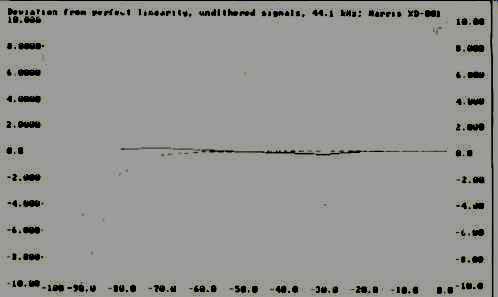
Fig. 8--Deviation from perfect linearity during playback of prerecorded, undithered
signals.
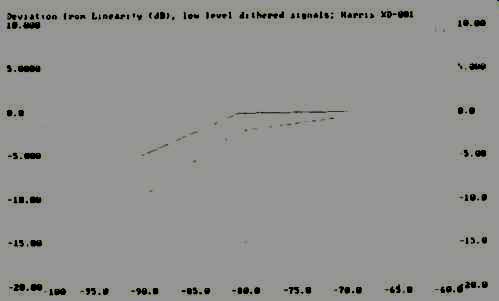
Fig. 9--Deviation from perfect linearity during playback of prerecorded, dithered
signal. Playback of-100 dB signal could not be picked up by the test equipment;
see text.
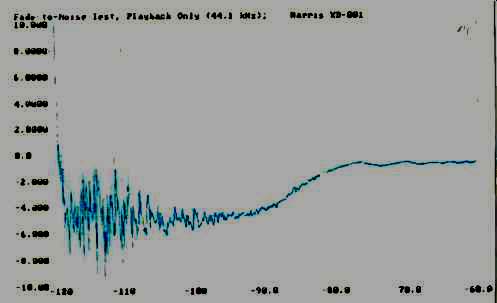
Fig. 10--Fade-to-noise test, for playback of prerecorded test tape.
Use and Listening Tests
Frankly, I haven't tested enough DAT machines to be able to precisely rank this one in terms of its sound quality relative to other DAT recorders. I recorded several tracks from some of my favorite CDs via the analog inputs of the XD-001 UH. I then attempted to make some non-double-blind (not even single-blind) NB comparisons between the original CD and the recorded version. Certainly, when I turned up the volume on my reference amplifier to louder levels than I would use for pleasurable listening, I could easily detect the higher noise floor of the DAT recording. On the other hand, when I recorded some of my own material using a moderately priced stereo microphone and a less than-professional little mike mixer I've had around for some years, the results were astounding--far better than I have ever been able to achieve with my half-track analog open reel mastering tape deck and certainly better than anything I've ever been able to do with my own reference cassette deck. Both of those recorders, by the way, had each cost me more than this lightweight, compact DAT recorder would.
Speaking of costs, I thought the Harris XD-001 UH was a bargain even at the $2,400 price it bore when it first arrived for review. I paid nearly this much for my own portable DAT recorder when I was in Japan, and it has neither remote control capabilities nor all of the features of the Harris. But then I learned that Harris has dropped the price of the XD-001UH to an amazingly low $1,550. If I didn't already own both a home-based DAT recorder and a portable, I would gladly spring for this Harris model.
-Leonard Feldman
(Audio magazine, Jun. 1989)
Also see:
Exclusive Test Report--Four DAT Recorders (Jul. 1987)
Sony DTC-75ES DAT Recorder (Equip. Profile, Nov. 1990)
Sony TCD-D3 DAT Walkman Recorder (Jan. 1991)
Akai AD-93 (DAT) Digital Audio Tape Recorder (Jun. 1988)
DECIDING ON DAT: Witness of the Persecution (Mar. 1988)
Nakamichi 1000 DAT Recording System (Nov. 1989)
= = = =